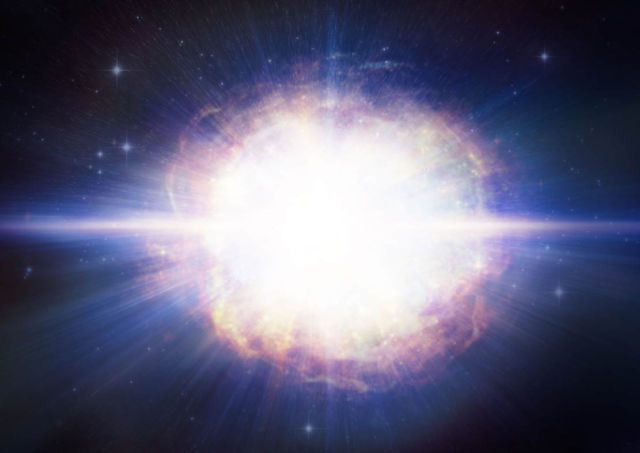Astronomers just detect the most powerful supernova – star explosion, ever observed.
The death of massive star leads to a spectacular explosion, a supernova, that outshine the entire galaxy.
Scientists at the Center for Astrophysics | Harvard & Smithsonian announced the discovery and study of the brightest, most energetic, and likely most massive supernova ever identified.
SN2016aps is believed to be an example of a “pulsational pair instability” supernova, and may have formed as the result of the merging of two massive stars prior to the explosion. The explosion energy of SN2016aps was ten times that of a normal-sized supernova.
“SN2016aps is spectacular in several ways,” said Edo Berger, Harvard University professor and co-author on the paper. “Not only is it brighter than any other supernova we’ve ever seen, but it has several properties and features that make it rare in comparison to other explosions of stars in the universe.”
The team—made up of researchers from CfA, University of Birmingham, Northwestern University, and Ohio University—first identified the supernova in 2016 using data from the Panoramic Survey Telescopes and Rapid Response System (Pan-STARRS). A four-year follow-up study tracked its slow evolution and significant energy release. Archival images retrieved during the study revealed a rising light curve dating back to December 2015, allowing the team to better understand the nature and explosion of the supernova.
In a typical supernova, radiation in visible light accounts for just one percent of the total explosion energy of 10^51 erg. In SN2016aps, the explosion energy of 10^52 erg is unprecedented, and the supernova radiated about 50 percent of this energy, making it outshine normal supernova explosions by 500 times.
“The intense energy output of this supernova pointed to an incredibly massive star progenitor,” said Berger. “At birth, this star was at least 100 times the mass of our Sun.”
Scientists don’t believe the explosion got that big on its own. “Spectroscopic observations during the followup study revealed a restless history for the progenitor star,” said Matt Nicholl, of the University of Birmingham and lead author of the study. “We determined that in the final years before it exploded, the star shed a massive shell of gas as it violently pulsated. The collision of the explosion debris with this massive shell led to the incredible brightness of the supernova. It essentially added fuel to the fire.”
SN2016aps also held another surprise for scientists: high levels of hydrogen gas. Massive stars typically lose the majority of their hydrogen to stellar winds long before they begin pulsating. “That SN2016aps held onto its hydrogen prompted us to theorize that two less massive stars had merged together, since lower mass stars hold onto their hydrogen for longer,” said Berger. “The new star, borne of the merger, was heavy with hydrogen and also high enough in mass to trigger pair instability.”
Image: Artist’s conception of SN2016aps, a candidate pulsational pair instability supernova. The explosion energy of SN2016aps, fueled by the shedding of a massive shell of gas, was ten times that of a normal-sized supernova, making SN2016aps the most massive supernova ever identified. Credit: M. Weiss
source Center for Astrophysics | Harvard & Smithsonian






Leave A Comment